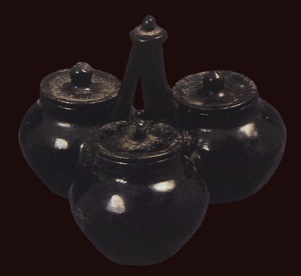
Onggi is Korea’s oldest and, for many ceramic artists, most fascinating ceramic art form. This year is an ideal year for us to begin Korean Onggi since Ulsan, Korea will hold their first annual Onggi Exposition. It is called “OEUK 2010” or Onggi Exposition Ulsan, Korea. The dates of the expo are still pending for 2010. This is a great opportunity for ceramic artists throughout the world to witness Korea’s only ceramic art form with an unbroken history from prehistoric times.
At one time we thought onggi was dying in Korea just as salt glazed crocks essentially died in America. When I was working in Korea in 1978-1979 there were onggi studios all over the country. Ten years later it was reported that the only remaining onggi artists were in their sixties and by 2008 onggi would be gone. Obviously that didn’t happen. However, refrigerators and plastic storage containers were replacing onggi. In one instance a huge and very old onggi factory with many workers and enormous kilns was closed to make room for a country club.
There were great losses in the number of onggi producing studios throughout Korea. Thankfully some families, particularly those with long traditions, remained. Such families as the Kim family in Yeoju, the Lee family in Bosong and many of the pottery families now in the onggi potter’s village in Ulsan as well as others remained. In addition, contemporary artists began to learn and use onggi methods to create some really interesting contemporary work. Onggi on Jejudo returned. It had died out there in the 1940’s or 1950’s. We could say, “Onggi is BACK!”. But it just refused to go away.
I will never forget standing with an onggi potter friend looking at a seven foot tall form by an internationally known contemporary ceramic artist during a WOCEF Exposition in Korea. He turned to me and said, “I understand it took him a week or more to make that and he used a fork lift to move it.” I told him that I had also heard the same thing. Then he said, “I could make that in a couple of hours and my friend and I could move it.” If you have ever seen an onggi ceramic artist work you know the power of their ability.
We have learned that onggi preserves food better than the modern methods. Onggi breathes. Koreans are returning to onggi to store many of their foods.
During the tour and beyond OEUK, you will visit onggi ceramic artists such as Kim Il Mann’s Father and Son’s Studio. That studio may be the only onggi studio that has gone back to the old ways of working. We have not seen these methods for thirty years and they are amazing. Kim Il Mann is a Human Cultural Treasure who uses coils to form his work. Their dragon kiln is also a cultural treasure. See our Kilns page (photos 1-4).
You will also visit the wonderful onggi potter Lee Hak Soo in Bosong. Bosong is famous or producing tea but we think of Bosong as the home of Lee Hak Soo who is another human treasure. His father was one of Korea’s most famous onggi potters. We believe Bernard Leach, Hamada Shoji and Yanagi Soetsu visited this studio many years ago. If you have not heard those names before you should look them up. Lee Hak Soo uses the flopped slab method for forming onggi. Bosong, where he lives, is close to Gangjin the celadon center of Korea. Gangjin is celebrating their millennium years and are helping to subsidize this ceramic tour to Korea. The processes used in making celadon are also amazing. They might even give you a workshop.
We are not limiting this tour to onggi. The tour will experience the full breadth of Korean ceramics. As mentioned you will also witness celadon artists. In addition you will visit a Silla style HCT, a porcelain HCT, Korea’s only National ICP in ceramics*, teabowl master, buncheong masters and some of Korea’s more important contemporary ceramic artists.
We are also not limiting the tour to ceramics. You will visit with Park Chan Soo a National ICP in Buddhist Woodcarving as well as visit the studios of other Korean HCT from various disciplines.
Autumn is also the time for the famous Andong International Mask Dance Festival which is claimed to be, “the most memorable, fascinating and fun time to be in Korea”. We hope the dates of the Andong Mask Dance Festival and the Ulsan Onggi Exposition will be close so that both events can be included in this tour.
South Korea is about the size of the state of Indiana. Although it is a small country, it has at least seven large museums dedicated just to ceramics. Several of these are large complexes. In addition there are nine National Museums which also have historic examples of Korean ceramics and a number of private museums. Sorry we won’t see them all. Korea may be the most ceramic conscious country in the world today. If you are a ceramic artist, you owe it to yourself to take a Morning Earth Ceramic Artist tour to Korea. This Onggi tour is so outstanding we are dedicating a web site to it.
Remember, all Morning Earth tours for ceramic artists and educators are priced at non-profit prices. Go to our links page to learn more.
Onggi in Korea


Register
Kiln Photos
Onggi Slide Show
Andong Mask Festival
Korean Onggi
More on Onggi
Ulsan Onggi Slides


This is also onggi.
click button





